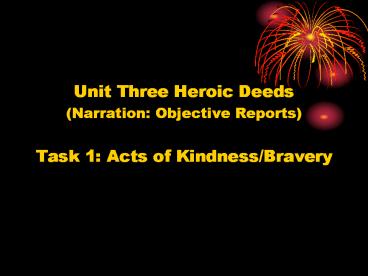Unit Three Heroic Deeds - PowerPoint PPT Presentation
1 / 17
Title:
Unit Three Heroic Deeds
Description:
Major types of point of view in narratives. Two important points ... impartially (fairly), what they have seen without offering interpretation and commentary. ... – PowerPoint PPT presentation
Number of Views:52
Avg rating:3.0/5.0
Title: Unit Three Heroic Deeds
1
- Unit Three Heroic Deeds
- (Narration Objective Reports)
- Task 1 Acts of Kindness/Bravery
2
- What is point of view?
- Major types of point of view in narratives
- Two important points about point of view
- Tips on how to write effective sentences
- Writing assignments
3
?. Warming up
- Review Narration Personal Narratives
- Essential elements of narration
- a series of events
- a narrator
- purpose
- Tips on how to write a personal experience
narrative - Topic sentence
- First person point of view
- Chronological order
- Transitions
4
?. Point of view and its types
- 1. Point of view
- Dictionary definitions
- a particular way of thinking about or judging a
situation. scientific/technical/business etc
point of view From an economic point of view ,
the new development will benefit the town
greatly. - someone's own personal opinion or attitude about
something I respect your point of view, but I'm
not sure I agree with you.from sb's point of
view From my point of view, there is no way they
can win.
5
- In writing the perspective (a particular way of
looking at something) the writer adopts toward a
subject. - 2. Major types of point of view.
6
?. Practicing point of view
- Identify the point of view in the following
passages and explain why it is suitable for the
narrative. - Passage 1 the first person point of view. The
narrator is a participant. This point of view
allows the narrator to express his opinions and
feelings about the students freely. - Passage 2 the limited third person point of
view. An unknown narrator describes what happened
and reports the mans thoughts and feelings. - Passage 3 the objective (dramatic) third person
point of view. The narrator merely tells what he
observes and does not go into the mind of anybody
involved.
7
- 2. For each of the following topics, discuss
with your classmates which point of view you will
choose and state your reasons. - Pair/group discussion.
- Presentation.
8
- The first person, for this point, of view allows
writers so easily express their joy and
excitement on such an occasion. - The objective third person, because witnesses are
supposed to report, faithfully and impartially
(fairly), what they have seen without offering
interpretation and commentary. - The first person, which allows expression of
attitudes and feelings, thus making the narrative
personal and vivid.
9
- 4. Both the first person and the limited third
person. The incident can be narrated by either a
first person narrator who is an observer or a
participant, or a third person narrator who goes
into the mind of one or more people involved. - 5. Both the first person and the limited third
person points of view can be used. The incident
can be narrated by either a first person narrator
who is an observer or a participant, or a third
person narrator who goes into the mind of one or
more people involved.
10
- 3. Correct the shifts in point of view in the
following sentences and short passages. - Individual work
- Peer discussion
- presentation
11
?. Reading on the subject acts of
kindness/bravery
- Individual reading
- Pair/group discussion on the questions that
follow. - Night Watch
- Leading the Charge
12
?. Writing Assignment 1
- Read the article The Broken Lantern and
summarize the story of how Kate saved the train
in about 200 words.
13
- Read the article The Broken Lantern and
summarize the story of how Kate saved the train
in about 200 words. - Get the students to read the story The Broken
Lantern. - Find out the sentences that provide information
about - The background important details about Kate
Shelley, the storm, etc. - The girls heroic deed how she saved the train
and a hundred or more passengers on it. - The way she was honored.
14
- Pair/group discussion on the selected facts.
- Work out a working outline
15
A Working Outline
- Introduction (background)
- Time _____________________ Place
___________________ - Important details _______________________________
________________________ - __________________________________________________
_____ - Body (the girls heroic deed)
- Urgency of the situation ________________________
_______________________________ - Risk and difficulties involved
__________________________________________________
_____ - __________________________________________________
_____ - Conclusion (how the girl was rewarded)
- __________________________________________________
_____ - __________________________________________________
_____
16
?. Summary and homework
- 1. Summary
- 2. Homework
- Writing the draft of your essay.
- Revising it.
- Peer evaluation.
- Submitting your essay for teacher evaluation.
17
- Thank you for your attention!
- See you next week!































